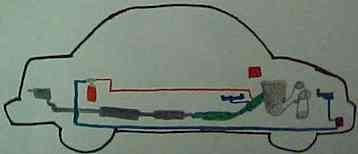
Propulsion

A propulsion system in Volvo cars.
| In older motors, a small explosion
from gasoline, a fossil fuel, created propulsion. That moved a piston, creating
power to the axle, while also creating a small amount of exhaust. Over the years,
this exhaust has built up, and gotten so great that we must look to alternative methods of
powering our vehicles. Since then, we have developed a few techniques that eliminate
this problem. One technique of eliminating exhaust is electricity. This method was developed a few years ago, but was proven not to be economical. Electric-powered cars were used from the beginning, along with gasoline cars. Over the years, electricity was too hard to power and it became easier and more economical to power by gasoline. Most electric cars use a rechargeable battery that can take a long time to charge, and can only go a distance of about sixty to eighty miles. About a year ago, scientists developed Nickel-Metal Hydride batteries that will go fifty to one hundred twenty miles. It also takes less time to recharge! While an old battery could take a night to recharge, these new batteries will recharge 60% in fifteen minutes, not to mention a full charge in one hour. A private company has also been developing batteries, and they came up with a battery called the Horizon. This battery can double the range while still recharging. Another technique of reducing and possibly eliminating exhaust is the new fuel cell system. This system reduces emissions to basically water! The fuel is made of water and air, and sometimes the air is not used. The hydrogen is drawn from water, and the oxygen can be drawn from the air or water. A byproduct of the fuel cell system is carbon dioxide, which is given off after the water is processed. The problem with this system is that the water is hard to carry around, and isn’t economical. That is why scientists have developed a car which uses a fuel cell system until a second device, called a catalyst, warms up. The catalyst causes a chemical reaction that changes the regular gasoline emissions into harmless byproducts. At this point, the engine switches to gasoline as the fuel. The third technique that Ford is developing is the stop-and-go engine. This reduces emissions, but does not eliminate them. You step on the accelerator, and the engine starts before you can even notice the change. Then when you hit the brake, the engine shuts off. This also conserves precious resources - fossil fuels. This system saves 8% fuel and creates fewer emissions. Ford is expecting this engine to come out in its Mondeo car. These are some of the ways scientists are attempting to reduce pollution and preserve natural resources. Scientists are also making the energy cheaper and more economical. This is making the world better, and providing people with better ways to get where they need to go faster. |
|||